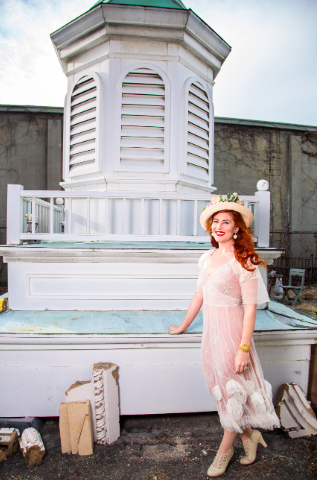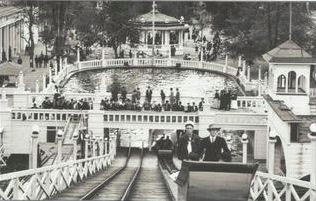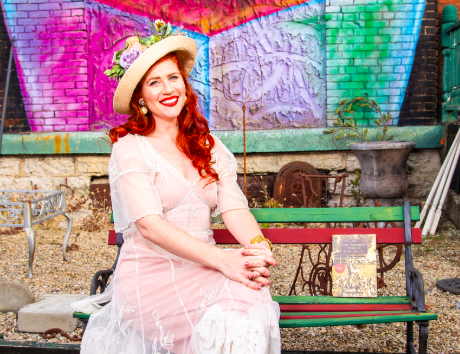Carrie Cooke Ketterman Authors New Book On Important Local History
Photography Provided
 Carrie Cooke Ketterman is a woman of many talents. She sings, acts, paints and owns an online Etsy craft shop. Originally from St. Matthews, Carrie now lives in Corydon, Indiana, with her husband Jeff, where they operate the Old Capitol Tea Room in their 114-year-old home. She performs in two bands, the 1920’s-inspired The Tin Pan Alley Cats and the 1950s-inspired Rosie and the Rockabillies. Carrie and Jeff make public appearances as one of the most iconic couples in television history, Lucille Ball and Desi Arnaz.
Carrie Cooke Ketterman is a woman of many talents. She sings, acts, paints and owns an online Etsy craft shop. Originally from St. Matthews, Carrie now lives in Corydon, Indiana, with her husband Jeff, where they operate the Old Capitol Tea Room in their 114-year-old home. She performs in two bands, the 1920’s-inspired The Tin Pan Alley Cats and the 1950s-inspired Rosie and the Rockabillies. Carrie and Jeff make public appearances as one of the most iconic couples in television history, Lucille Ball and Desi Arnaz.
Carrie is also the author of a new local history book called “Lost Amusement Parks of Kentuckiana” which is part of the popular “Images of America” series produced by Arcadia Publishing. The inspiration for the book was sparked by Carrie’s childhood memories.
“I’ve always been fascinated with amusement parks,” Carrie says. “It started with Coney Island. Every summer my family and I would go to New York, and while my mom would take off to see all of the fantastic art museums and stay in Manhattan, my dad and I would catch the subway and go up to Coney Island. I thought, ‘This is such a cool place.’”
Carrie started the project by doing some research on Coney Island and the history behind the park.
“The interest I had in Coney Island made me think that I needed to research the amusement parks that were once in my own backyard,” she says.
The first park to capture Carrie’s interest was Fontaine Ferry Park, a place she’d heard her parents mention from time to time. She was also familiar with the place because her father, an antique collector, had a poster from the park.
“If you talk to any old-timers around and mention Fontaine Ferry Park, chances are they will tell you a couple of stories about going there when they were kids,” Carrie says.
Another park, Rose Island, first known as Fern Grove, became another point of interest for Carrie.
“Three years ago my mom told us about Rose Island and I began asking her questions,” she says. “It was an amusement park in the 1920s but was taken over by Charlestown State Park. They’d reopened the grounds, allowing you to go in to see what they’d done to preserve the history of the park. She took me and my brother and my aunt there, and we went hiking through Rose Island to see what was left of this vintage amusement park.”
 Carrie was so intrigued by these parks that she began doing research to learn about them but came up with little to nothing about their history. She began searching through the “Images of America” series to see if anyone had written books on Fontaine Ferry or Rose Island, but again, nothing was available. This was a pivotal moment for Carrie.
Carrie was so intrigued by these parks that she began doing research to learn about them but came up with little to nothing about their history. She began searching through the “Images of America” series to see if anyone had written books on Fontaine Ferry or Rose Island, but again, nothing was available. This was a pivotal moment for Carrie.
As she was searching for information, she found a link on the Arcadia Publishing website instructing readers on how to submit a book proposal. She decided to pitch her idea.
“I sent in a proposal saying that someone should write this book, and a couple of weeks later I got an email saying they liked my idea and asked me to write it,” Carrie says.
She decided to take the plunge and received a packet from the publisher explaining how their format worked. It took Carrie three years of research and editing before the book was finally published.
The book covers five amusement parks which were quite popular in their day: Rose Island, located in Charlestown, Indiana; Glenwood Park, located between New Albany and Jeffersonville, Indiana; and Fontaine Ferry Park, White City and Kiddieland on the Louisville side of the river. The 127-page book is divided into seven chapters, one for each of the five parks, plus an opening chapter titled “Life Along the Ohio” and a closing chapter called “What Remains Today.” Each chapter includes photographs, artwork or vintage advertisements. Although the book is primarily a pictorial depiction of these historic landmarks, each chapter includes an extensive introduction along with comprehensive captions for each photograph.
A good deal of Carrie’s investigative work involved visiting local libraries, but she discovered other avenues that helped along the way.
“I went to the New Albany Library, the Charlestown Library, and I visited the University of Louisville archives,” she says.
Social media connections also played a key role by introducing her to individuals she could talk with about the amusement parks.
“I met a lot of wonderful people through Facebook groups like Remember When in Louisville,” Carrie says. “People were showing pictures from when they were at Fontaine Ferry or Kiddieland. I would message them to see if they had any pictures they were willing to share for the book.”
Carrie also had a connection to the parks through her father.
“Bill Matheis, my dad’s friend’s father, had been one of the general managers at Fontaine Ferry and the owner of Kiddieland,” she says. “The family had three photo albums of pictures, and ads and other things he’d clipped out of the newspaper. I really lucked out there. It was such a treasure trove of information. One of the albums was his personal family album that had pictures of workers and staff from Fontaine Ferry.”
Jeremy Beavin, who leads walking tours of Rose Island at Charlestown State Park, also provided information for the book.
“(Jeremy) was fantastic,” Carrie says. “I met with him several times and he let me use the park’s binder of photos and information.”
Others who helped her write the book and provided pictures included David Barksdale, who had vintage postcards from Glenwood Park, John Findling, author of the “Images of America” book about St. Matthews, and Barbara Montgomery, whose family had once owned the “Idlewild” boat (now known as “Belle of Louisville). “Idlewild” was used to ferry guests to the amusement parks along the Ohio River.
The book is a joy to read, incorporating very sweet and delightful pictures showcasing the lifestyle of park visitors a century ago who were simply enjoying the natural beauty along the river, bathing in pools, canoeing, camping, and picnicking with family and friends. Other photos capture more modern images of children and teens on rides such as the Tilt-A-Whirl and the Turnpike at Fontaine Ferry Park, or on pony rides at Rose Island. Advertisements in the book for White City beckon visitors by offering performances by Professor Baumeister’s Wild Animals, and Cora Youngblood Corson and her celebrated band of women. A 1915 photograph shows Dreyer’s Concert Band at Glenwood Park. A thoughtful handwritten letter from a teacher to Bill Matheis, expressing her gratitude for allowing her students to visit his park, can be found in the chapter about Kiddieland.
Although these parks are a distant memory for many, Carrie’s book brings them alive due to her extensive research and keen eye for descriptive photographs. Older residents can relive their childhood by thumbing through the pages, while younger readers will learn that past generations aren’t so very different from people today.
Carrie’s book can be purchased in local bookstores and through Arcadia Publishing at arcadiapublishing.com.







Comments 2
You sent a painting of my daughter’s dog Gary in Louisville and we love it but who paid you? Please let me know your thoughts your very talented